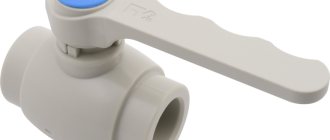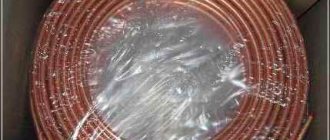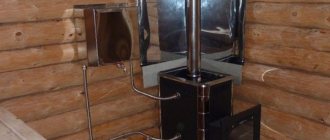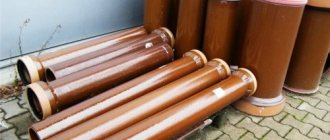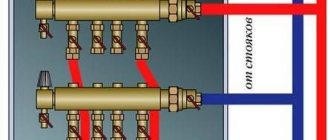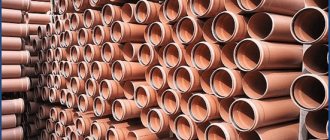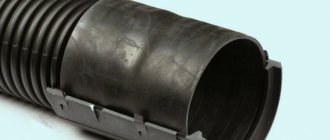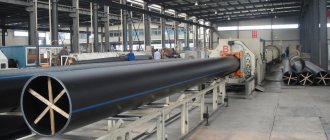When making a pipeline from plastic, it is necessary to connect the pipes with shut-off valves to make it possible to regulate the fluid flow rate and shut off the circuit during repairs or the manufacture of additional branches. Regulating elements must withstand high pressure, be resistant to temperature changes, and water hammer. The HDPE tap is an inexpensive, reliable part for shutting off pipelines.
HDPE tap with fittings
Crane device
The design of a polyethylene shutter is not much different from analogues made from other materials. A cast body containing a locking mechanism controlled by a lever-like handle. Polymer seals provide tightness to the housing.
Mostly, ball valves are used, the locking device of which consists of a ball with a slot, a stem and sealing seats in contact with the locking element. The diagram of such a device is shown in the photo.
Scope of application
HDPE pipes are used to connect various structures and control flows. On the one hand, they impart tightness to the elements, while on the other hand, they allow the pipe to be opened or closed. They are used to manipulate gaseous and liquid substances, including those with aggressive properties. HDPE ball valve with valve is used for systems:
- technical and drinking water supply;
- sewerage;
- glaze;
- gas supply.
There are a number of differences in the composition of such elements, both externally and internally. For example, if the element is planned to be installed on pipelines for supplying cold water, they are painted blue. As for the design, there are modifications of pipes:
- corner;
- multi-pass, when there are 3 or more inlet pipes;
- checkpoints.
Advantages and disadvantages
Let's look at the pros and cons of a polyethylene tap.
Buyers include the following advantages:
- complete anti-corrosion of the product;
- light weight, which is important for plastic highways;
- simplicity and ease of installation;
- low price, which is due to the relatively low cost of production.
This type of fittings, like many HDPE fittings, also has disadvantages:
- can only work in an environment with a temperature no higher than 45 (not to be confused with polypropylene valves, which are capable of working in a heating system);
- the control handle often loses its fixation and begins to rotate;
- quickly becomes cloudy and loses color when exposed to sunlight;
- In terms of calculated operating pressure, it is inferior to metal analogues.
Main characteristics
HDPE taps for HDPE pipes are designed to completely shut off the liquid passing through them. They are called spherical because they have the appropriate shape and a through hole. This element can rotate by rotating 90° in the housing. After appropriate manipulations, it is possible to close or open the passage. You can change the position of the mechanism using a lever.
Slightly different possibilities are provided for large-diameter parts with dimensions of 150 mm or more. The locking mechanism in them is regulated by pneumatic, electric and hydraulic drives. The body of these elements is made of HDPE, just like the pipes. When creating a locking mechanism, manufacturing companies resort to using various types of plastic or polypropylene.
Considering the advantages of fittings, it is worth highlighting the long service life of these products. It is at least 25 years old. The service life is influenced by the conditions in which such elements are used. The following advantages of the equipment are also worthy of attention:
- Affordable price. This is explained by the fact that the materials for manufacturing are inexpensive.
- Reliability due to simplicity of design.
- Light weight of components.
- Maximum tightness.
The likelihood of corrosion is minimized since the equipment is made of plastic. This is a material that is not susceptible to sediment formation.
These products have some disadvantages. They are not suitable for flow control because they can break quickly. Like any other HDPE fittings, they are produced with minimum pressure in mind. In this regard, they are inferior in capabilities to metal elements. The strength of the device decreases under the influence of thermal factors. Before using a ball valve for HDPE pipes, it is necessary to determine whether its performance meets the operating conditions.
Types and designs
There are different types of polyethylene valves based on the methods of connecting working lines to pipes.
Compression taps (pictured). Any summer resident can install them with his own hands. No equipment is needed, just an adjustable wrench and a sharp knife or file are enough just in case. The pipe is cut to a chamfer, inserted into the collet and body until it stops, and the connection is secured with a crimp nut. This connection is used in low-pressure systems.
Welded taps (pictured). They are connected to HDPE pipes using a welding machine. Used when particularly strong sealing of joints is required. Recommended for underground wiring.
Threaded connections in polyethylene valves are very popular. They are used in combination with transition fittings, in particular tees. Taps are produced with different threads on both sides.
Faucet coupling - female thread:
A valve with a female-to-female thread:
Flange connections are used in large-sized pipelines.
Varieties
On sale you can find several types of HDPE ball valves, which differ in the method of connection with other pipeline parts:
- Compression valves are shut-off valves that can be installed by anyone without specialized equipment or practical skills. For installation you will need a file and an adjustable wrench. The diameter of the structure is from 20 to 110 mm. These are detachable parts that can be removed at any time. Not suitable for high pressure systems.
- Welded - valves that are used in the assembly of pipelines with high tightness of joints. To install such parts, you need to use specialized equipment. After heat treatment, tight connections are obtained.
- Flanged - shut-off valves used to connect large diameter pipes (up to 315 mm). There are metal flanges installed on both sides, which are connected using bolts and nuts. To increase the tightness of the connection, a rubber gasket is fixed between the flanges.
- Threaded - parts with which you can obtain a detachable connection. A thread is cut on both sides of the shut-off valves, which can be located on different sides of the outlet pipes.
Attention must be paid to welded joints. To do this you need to prepare specialized equipment:
- Electric couplings. The product is put on two connected elements and current is passed through it. The inner spiral heats up, the plastic melts, forming a sealed connection.
- Welding machine. Teflon-coated nozzles are attached to the soldering iron and heated to 260 degrees. After this, the ends of the pipeline elements are put on nozzles, heated, and connected to each other.
For country water supply, it is advisable to choose detachable parts so that you can dismantle the system before the onset of winter.
Tips for choosing
The device must comply with the standard sizes and technical parameters that are typical for the pipeline where it will be installed. The standard dimensions, primarily the cross-section, thread pitch, as well as operating pressure and temperature indicators of the tap and main pipes must match. This information is indicated on the product labeling.
It is important to select fittings from the same material, the same brand, from which the pipeline is made. It is better to choose this polymer for PE pipes.
Low-density polyethylene is the optimal material for carrying water into a house from a well or borehole.
You need to buy devices in specialized stores, where a wide catalog from various manufacturers is available.
Cast fittings for HDPE pipes
In addition to HDPE ball valves, other elements that relate to accessories for HDPE pipes are also used in polyethylene communications. Fittings for HDPE pipes are usually selected based on the diameter of the communication.
HDPE fittings are most often used in water supply systems. Such communications can be of two types:
- external;
- internal.
External polyethylene pipelines are installed mainly in a closed way (underground). Internal communications are laid directly in the premises.
Components for polyethylene pipes are also called “spingots”. Such shaped parts can have a variety of designs and be used for different types of HDPE pipe connections.
Let's look at the main types of connecting elements for HDPE pipes:
- HDPE bushing for flange;
- HDPE outlet;
- transition;
- tee.
In addition to shut-off valves, when installing HDPE it is necessary to use tees, bends, couplings and other types of fittings
Rules for installation and operation of the crane
Installation of polyethylene fittings is simple and accessible for any home craftsman. The only difficulty is the welding joint, where equipment and certain experience are required.
Before installing the gate, make sure once again that it matches the existing main in all respects. If soldering is to be done, the pipes and valve must be made of the same material.
The installation location is chosen in such a way that the crane is accessible for operating the handle and for prompt dismantling.
Polyethylene locks can withstand frost, but they need to be inspected periodically and the nuts must be tightened.
Required tools and materials
- For compression connections, you will need a knife to cut the pipe chamfer.
- For installation in drip systems you will need a drill and a drill of the required diameter.
- For soldering you will need a special soldering iron and plastic scissors.
- The only materials you need are the device itself.
Work progress
The ends of the pipes are cut strictly at right angles. This is best done using special scissors for cutting plastic pipes, which are guaranteed to ensure perpendicularity.
Use a knife to chamfer both ends. They remove the garbage.
Put a clamping nut on each pipe, then a collet (clamping ring), an O-ring, and insert the pipe into the valve body until it stops.
The crimp nuts are tightened first by hand, then using a wrench.
Installation description
There are several ways to install a ball valve. The thermistor or butt welding method is the most reliable in terms of tightness . This connection option minimizes the likelihood of dismantling the crane in the future. The connection via flanges makes the valve reusable. If replacement is required, it can be carried out without the use of specialized equipment.
In most cases, flanged valves have 2 open-close positions. They cannot be used to control flow power. They are made from stainless steel or cast iron. They are installed on large diameter objects, for example, in gas pipes or oil pipelines. These are the most durable cranes. Their body can consist of two parts or be cast.
The coupling connection is used in water supply and heating systems when the cross-section of pipes does not exceed 45 mm. The simplest are coupling valves. They are easy and convenient to use.
Union valves are connected by a nipple and nuts. The connection areas must be sealed with gaskets. This fastening option makes it possible to reuse the cranes. There is a combined installation. This combines flanges and welding.
HDPE tee for polyethylene pipes
Another important connecting element that is necessary when installing polyethylene communications is the HDPE tee. This shaped element is necessary to connect an additional branch to the main (main) pipe.
A tee is a part used to branch a pipeline
As a rule, pipes with the same cross-sectional dimensions are connected using tees. In this case, all three branches of the tee for HDPE pipes have the same diameter (equal tee). However, there are cases when it is necessary to connect pipes with different diameters, and then a special adapter tee is installed, the bends of which differ in cross-section.
Let's consider situations when the use of such a fitting is necessary:
- laying polyethylene multichannel communications (in production);
- installation of water supply in an apartment building;
- use of one water source for different purposes;
- creating points for exiting the working environment from communication.
Tees are quite in demand when it is necessary to make a branch from the central highway. The HDPE tee is an effective fitting that is easy to install and easy to maintain.
The cross-sectional parameters of tees vary from 30 to 1200 mm, which allows them to be widely used for the installation of polyethylene communications in various sectors of human life.

